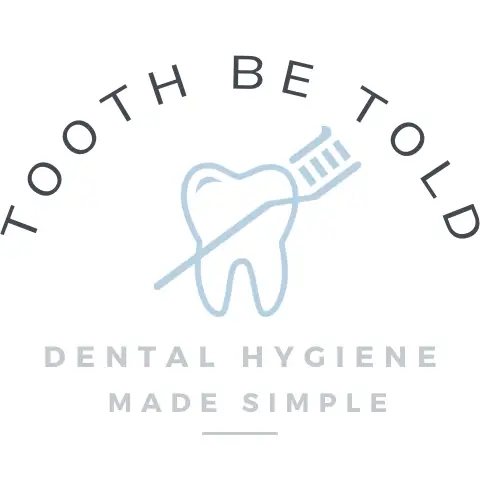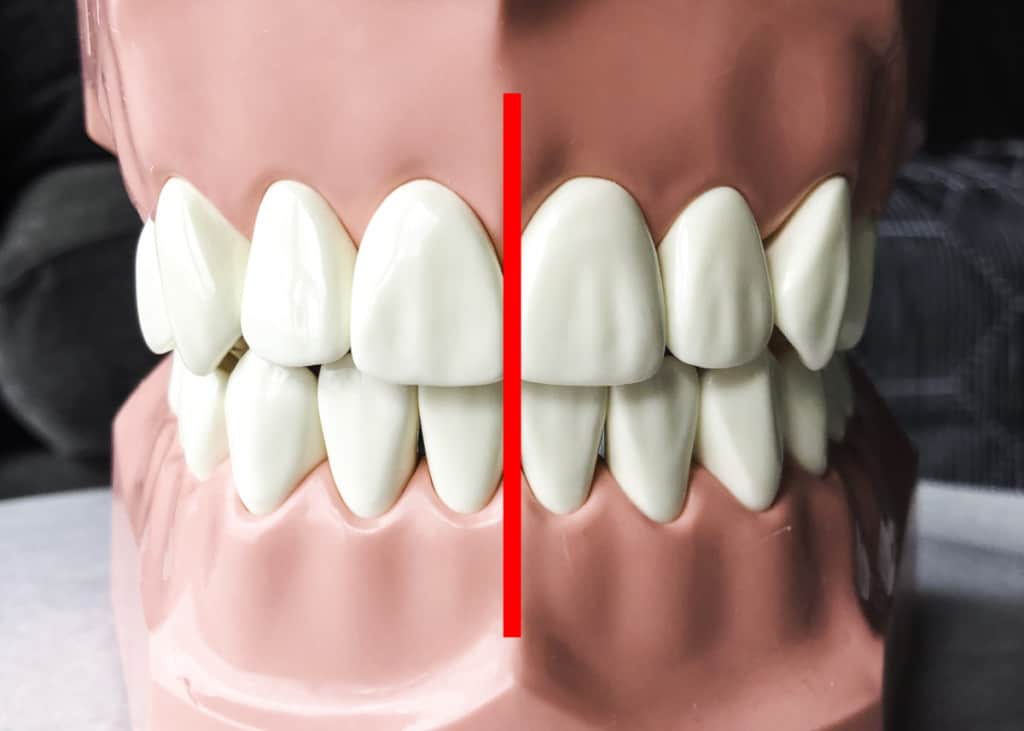
Our mouth is the gateway to our entire bodies, and how we bite (also called occlusion), and how our teeth are aligned can impact our oral health. The way our teeth are aligned can also impact our speech, how we eat, and how we smile and affect our self-confidence.
In proper occlusion, the midline of the top teeth lines up with the middle of your upper lip and nose. The midline of the bottom teeth lines up with the midline of the top teeth. When biting, the back teeth touch and the top teeth overlap in front of the bottom teeth by a couple of millimetres.
Many factors impact the occlusion of our teeth. In this post, I go over how teeth should come together with proper alignment. I also go over the most common bite problems (also called malocclusion), their causes, how they are fixed, and how they impact our oral and overall body health.
Perfect teeth alignment: How teeth should line up
The middle of the top teeth and the lower teeth should line up together in a straight line. If the midlines of the top and bottom teeth do not match up, we call this a midline shift.
We can determine which arch of teeth is shifted by using a piece of floss stretched over the midline of the face, extending from the bridge of the nose to the chin. The top teeth should be in line with the middle of the face/nose, with the middle of the lower teeth following the same line.
Hopefully, the nose hasn’t been broken a couple of times, and if the nose is not in line, we can look at other landmarks to use, such as the middle of the eyebrows and chin.
Below is a link to a post I wrote about how your teeth are supposed to sit when your mouth is resting. It also includes 11 ways how to tell if your bite is off.
Read Now: Are Your Teeth Supposed to Touch When Resting? RDH Explains
Perfect bite teeth alignment side view; with pictures
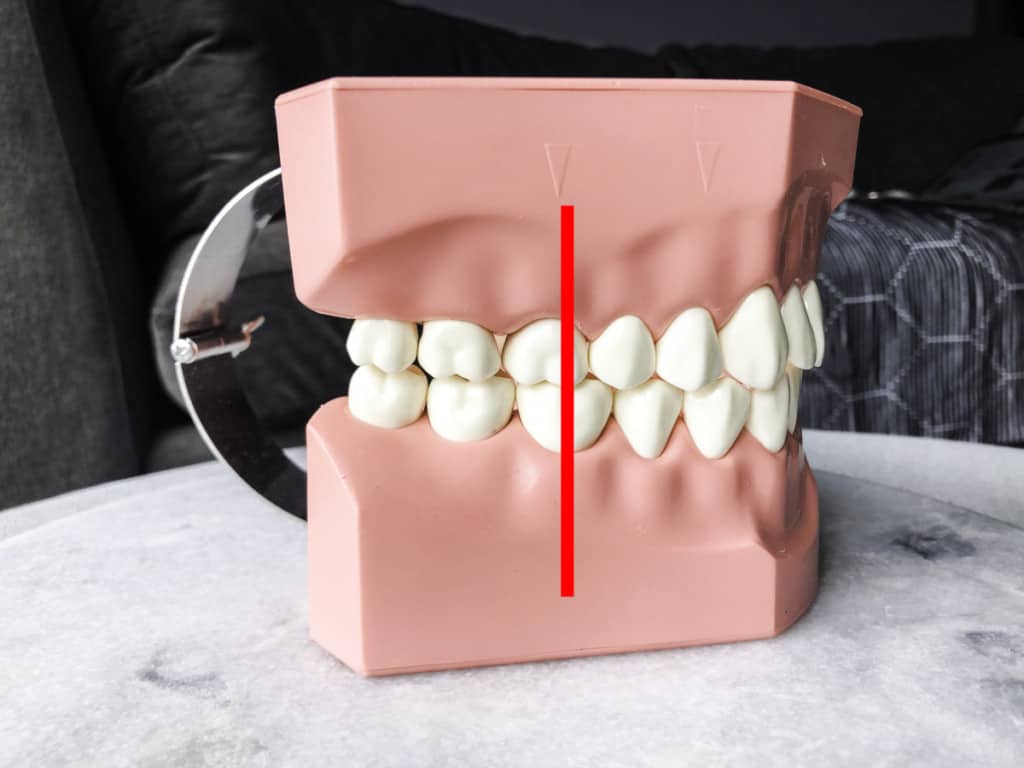
On the upper arch, the first molar’s front cusp should line up with the middle of the lower first molar. This is known as a class 1 molar relationship.
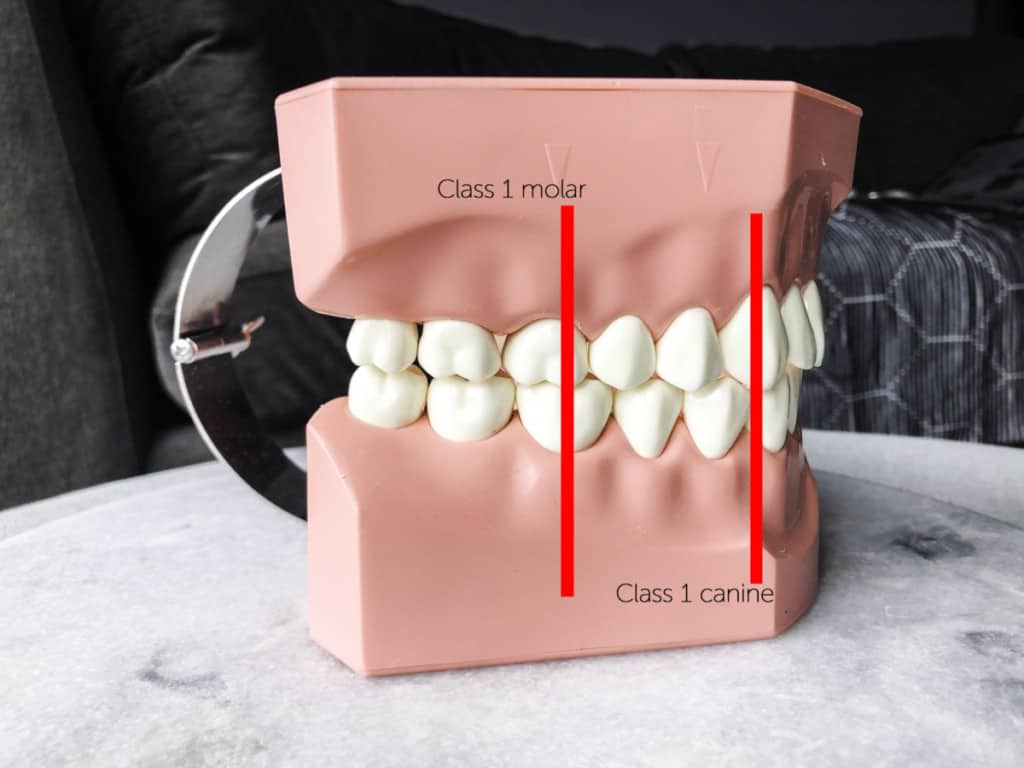
The canines (the pointy teeth and the 3rd tooth from the midline) should line up similarly. The upper canine’s cusp should align in the middle of the lower canine and first premolar. You can see the above picture for reference. This is called a class 1 canine relationship.
Should top and bottom teeth touch? With pictures
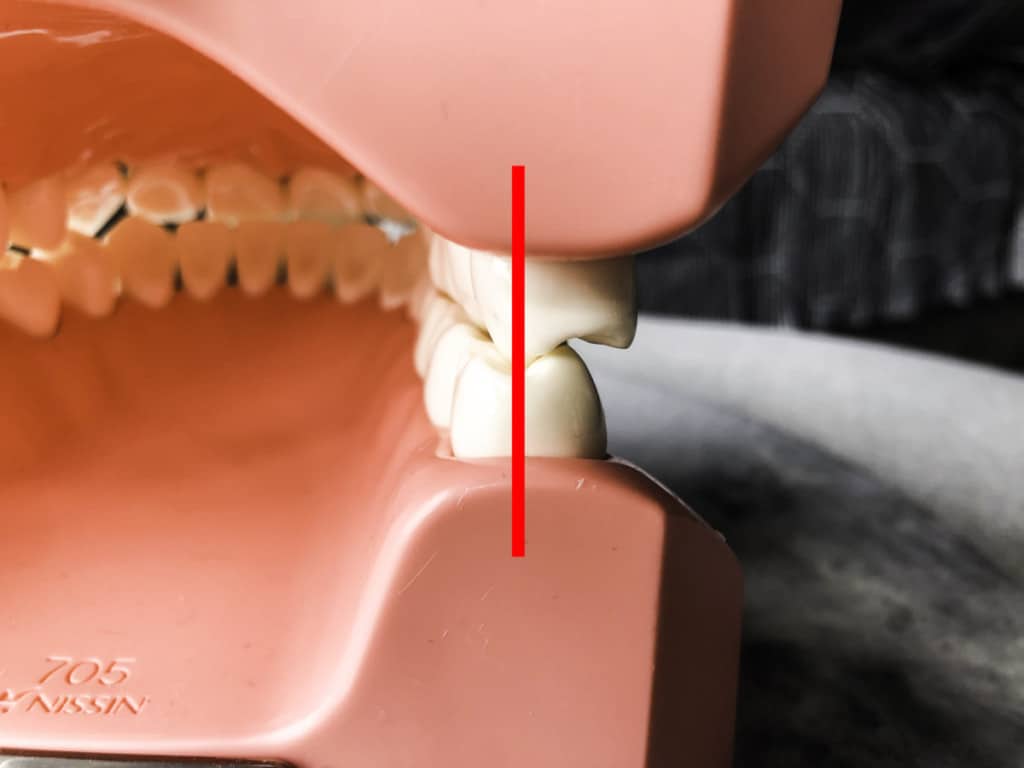
The upper teeth should always overlap the lower teeth and be closer to the lips and cheeks. If they do not, an edge-to-edge bite, underbite, or a cross-bite occurs.
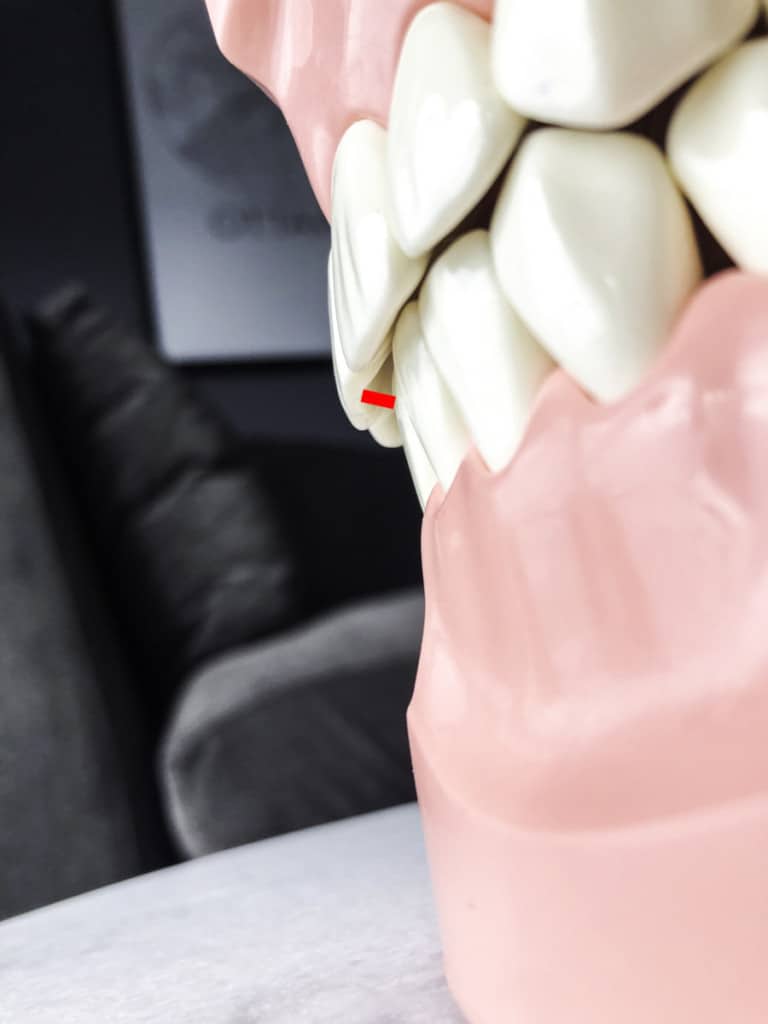
The upper front teeth should jet out over the lower front teeth by a couple of millimetres. The ideal is 1.5 to 2.5 mm overjet. This is called overjet and can commonly be confused with an overbite.
Overbite is how far the top front teeth come down on the lower front teeth, closer to the gum tissue around the bottom teeth. You don’t want the top teeth coming down too close to the gum tissue, as it can damage the gums.
Read now: What To Do if Teeth Shift Back After Braces? How To Fix
Common issues with the occlusion
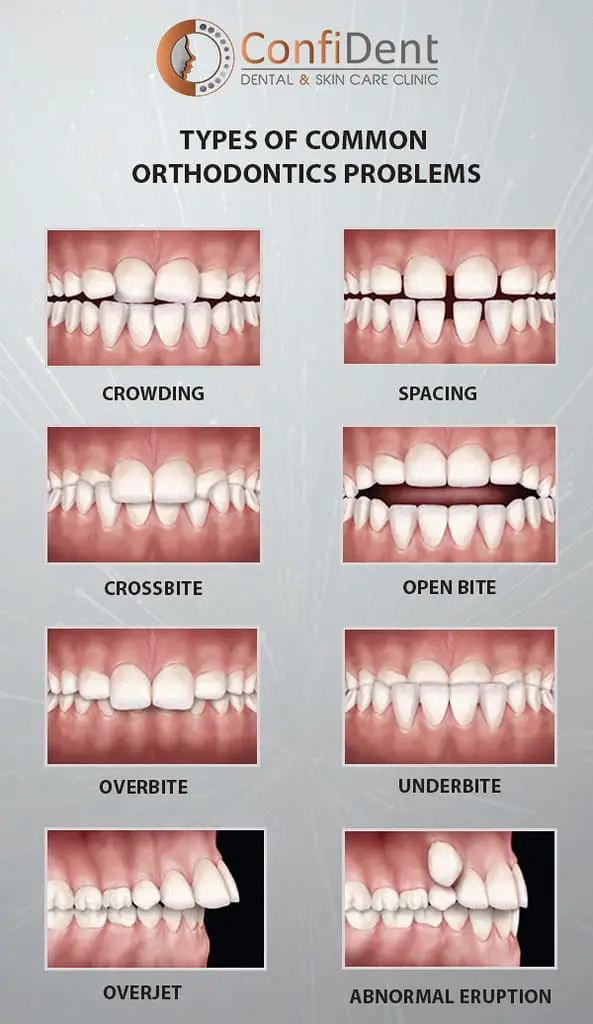
We look for a few different things when assessing someone’s bite/occlusion. Sometimes things in the mouth that are misaligned or misplaced can be easily overlooked. The following topics are common issues that can occur.
What is Overbite (deep bite)? Hygienist explains
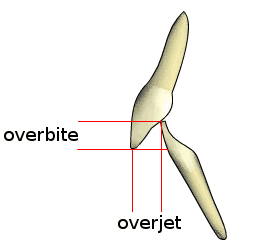
An overbite is how far down the front teeth overlap in front of the bottom teeth. An ideal overbite is around 3-5 mm. Anything over 5 mm is considered a more deep bite and may begin to impinge on the gum tissue and cause other issues.
If the teeth are impinging on the gums, it can cause gum recession and even an overload of force on the teeth that can prompt bone loss.
What is Overjet of teeth? Hygienist explains.
Overjet is how far the upper front teeth jet straight out from the lower front teeth. Ideally, you want about 1.5 mm to 2.5 mm. If there is too much of an overjet, it can make biting into things, speech and how the lips close together will be affected.
What is Cross-bite of teeth? Hygienist explains!
The upper teeth are supposed to overlap the bottom teeth and be closer to the lips and cheeks. A cross-bite occurs when the lower teeth/tooth overlaps the upper teeth/tooth and is closer to the lips and cheek. It could be just one tooth, multiple teeth, front teeth, or one side of the mouth.
Hygienist explains Underbite (also known as anterior cross-bite)
An underbite is when all the lower front teeth are in front of the upper front teeth. Because it involves all the front teeth, it is also called an anterior cross-bite. It can also be called a Class 3 malocclusion.
What is an Open bite? Pictures included!
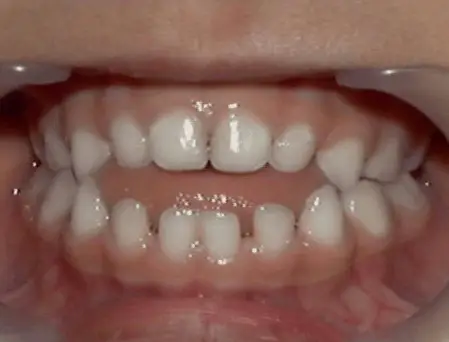
When teeth bite down and do not touch together, it is called an open bite. An open bite can occur anywhere in the mouth. It is called an anterior open bite when the front teeth don’t come together when biting down. It can make biting into things challenging and impossible for some people as the front teeth help slice and tear the food we bite into.
Midline shift: teeth don’t line up when biting down
You can have either a maxillary midline shift (top teeth) or a mandibular midline shift (bottom teeth). Midline shift occurs when the midline of your teeth does not line up together and does not match the midline of the face.
Edge-to-Edge bite: What is it? Hygienist explains!
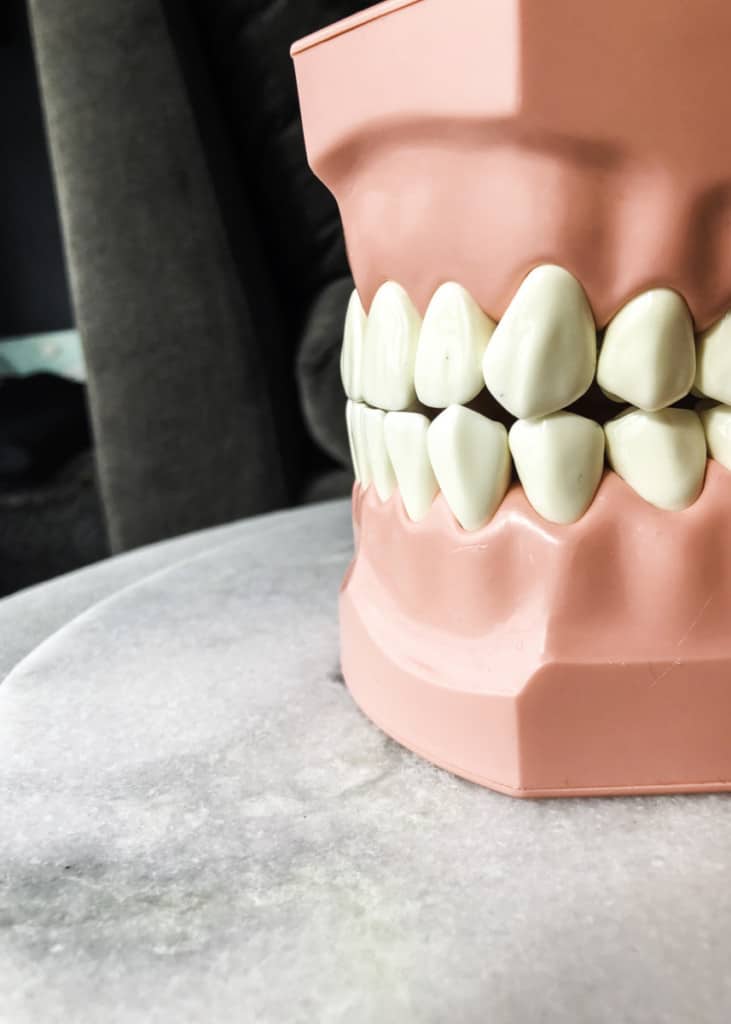
Edge-to-edge is when the top front teeth are directly on top of the bottom front teeth when they bite together. The edge of the top teeth meets the edge of the bottom teeth. Biting edge-to-edge increases wear, chips, and cracks on teeth.
But there is more to just a beautiful-looking smile. Read more about that in the link I posted below.
Read now: Cosmetic or Medical? Reasons Why Dental Braces Are Needed
Causes of malocclusion
74.7% of the population has malocclusion. Some of the main reasons for malocclusion are:
of the population has malocclusion. Some of the main reasons for malocclusion are:
Hereditary factors
The jaw size and the teeth’ general shape run in families. And it can make the difference in how much room there is for the teeth to come in.
I have my mother’s smaller jaw and my dad’s larger teeth, so there wasn’t enough room for my teeth to come in perfectly. This resulted in me going through orthodontic treatment to move my crooked teeth and fix my malocclusion.
My brother got my dad’s larger jaw and my mother’s smaller teeth, so he had enough room for all his teeth. Because of his genes, his teeth came in perfectly straight, and he didn’t need any orthodontic treatment. The lucky guy!
Tongue thrusting: Effects on teeth alignment
When the tongue is continuously pushed against the front teeth, it can make them shift forward, causing bite issues. People who thrust their tongues can have an appliance put in their mouth that prevents the tongue from touching the front teeth.
How thumb sucking affects bite; Hygienist explains
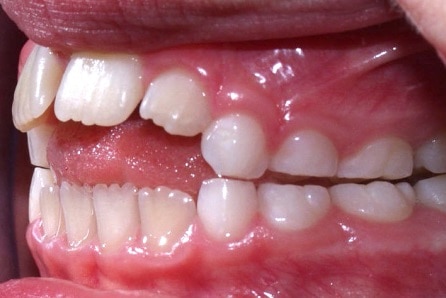
Thumb sucking can push the palate and front teeth up and out of the mouth. It can cause protrusion of the teeth, causing an open bite.
As you can see in the picture above, the person’s thumb-sucking habit has caused quite a severe anterior open bite and reshaped their mouth’s palate.
Prolonged use of pacifiers and baby bottles: bad for teeth
When pacifiers and baby bottles are used past their recommended time of use, the constant pressure and sucking can make the teeth at the front of the mouth jet out and could cause an open bite and changes in the palate. It can cause similar effects as thumb sucking.
How bite issues are fixed
Orthodontics and surgery are both done to correct bite issues. But also prevention methods can be successful.
Prevention of thumb sucking and tongue thrusting and limiting and stopping the use of pacifiers and baby bottles can make a huge difference.
It can be difficult to break these habits, but doing so will prevent the problems associated.
Orthodontics, through the movement of teeth, can use both braces and clear trays such as Invisalign. Retainers, palate expanders and space maintainers can be added to the list of orthodontic treatments that may be done.
My sister had a palate expander, and because the palate expander was used when she was much younger, it eliminated the need for braces.
Oral surgery to correct occlusion is rare and used in more severe cases. An oral surgeon will perform these treatments, and orthodontics is usually used in conjunction to achieve the best results!
How bad teeth alignment bite affects oral health
When teeth are out of proper alignment, keeping them clean and maintaining a healthy mouth can be hard.
The teeth are shaped so that when we eat, the food helps clean/scrape the teeth, removing some of the built-up plaque. When people avoid a specific side of their mouth when they eat, there is usually more build-up on that side they avoid.
When I am doing an exam of the mouth, and there is more build-up on one side, it can be an indication that something is bothering the patient on that side. It could be an uncomfortable tooth, lack of teeth or the teeth don’t bite together as well.
This puts the side that is doing all the work under a lot of stress. When one side of the mouth does all the work, it can make those teeth wear out more and cause problems, including;
- recession,
- gum disease,
- cracked and chipped teeth
- muscle issues that can lead to headaches and jaw pain.
Having all the teeth healthy and working together as a whole unit protects the whole mouth and, ultimately, our whole body.
Other effects of malocclusion
A bite that doesn’t fit together properly can affect our speech, eating, smiling, and self-confidence.
Speech
When we speak, we use our tongue, the roof of our mouth, and our teeth to form the sounds that make up words. If the teeth are in a poor position, it can affect how we speak. Lisps and other speech issues can come from malocclusion.
Eating
As I mentioned earlier in the post, having teeth that don’t come together well can make eating certain foods difficult. Each tooth in the mouth has a unique and important role; if it’s unable to perform as it should, things can become a little difficult when eating.
I had one patient whos back teeth did not touch together when biting down. It made eating for him extremely difficult, and he had to avoid some of his favourite foods because he couldn’t chew or grind it up with his teeth before swallowing.
Self-confidence
I remember I was conscious of my smile before I had braces to correct my bite. I tried to stifle my outburst of laughter, or as my husband likes to call it, the caggle (the mix between a cackle and a giggle). I avoided smiling big, and I hated speaking in front of a group. It really affected my self-confidence.
Not that people should be self-conscious of their smiles, but it’s natural to have feelings of insecurity.
Holly 🙂
